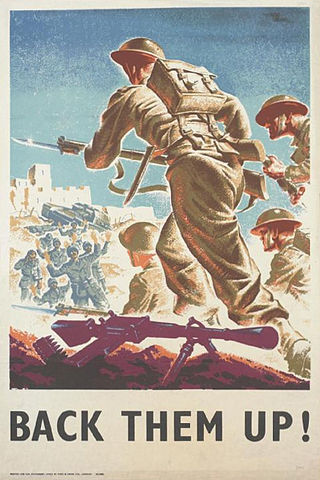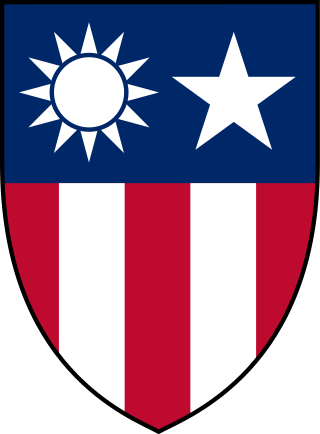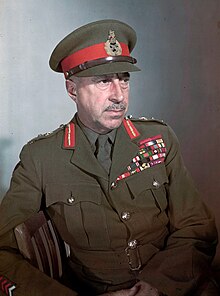
Field Marshal Bernard Law Montgomery, 1st Viscount Montgomery of Alamein,, nicknamed "Monty", was a senior British Army officer who served in the First World War, the Irish War of Independence and the Second World War.

The military history of the United Kingdom in World War II covers the Second World War against the Axis powers, starting on 3 September, 1939 with the declaration of war by the United Kingdom and France, followed by the UK's Dominions, Crown colonies and protectorates on Nazi Germany in response to the invasion of Poland by Germany. There was little, however, the Anglo-French alliance could do or did do to help Poland. The Phoney War culminated in April 1940 with the German invasion of Denmark and Norway. Winston Churchill became prime minister and head of a coalition government in May 1940. The defeat of other European countries followed – Belgium, the Netherlands, Luxembourg and France – alongside the British Expeditionary Force which led to the Dunkirk evacuation in June 1940.

General Andrew George Latta McNaughton was a Canadian electrical engineer, scientist, army officer, cabinet minister, and diplomat.

The 2nd Canadian Division, an infantry division of the Canadian Army, was mobilized for war service on 1 September 1939 at the outset of World War II. Adopting the designation of the 2nd Canadian Division, it was initially composed of volunteers within brigades established along regional lines, though a halt in recruitment in the early months of the war caused a delay in the formation of brigade and divisional headquarters. With questions concerning overseas deployment resolved, the division's respective commands were formed in May and June 1940, and at British Prime Minister Winston Churchill's request, the division was deployed to the United Kingdom between 1 August and 25 December 1940, forming part of the Canadian Corps.

The North African campaign of the Second World War took place in North Africa from 10 June 1940 to 13 May 1943. It included campaigns fought in the Libyan and Egyptian deserts and in Morocco and Algeria, as well as Tunisia. The campaign was fought between the Allies and the Axis Powers. The Allied war effort was dominated by the British Commonwealth and exiles from German-occupied Europe. The United States officially entered the war in December 1941 and began direct military assistance in North Africa on 11 May 1942.
An army group is a military organization consisting of several field armies, which is self-sufficient for indefinite periods. It is usually responsible for a particular geographic area. An army group is the largest field organization handled by a single commander – usually a full general or field marshal – and it generally includes between 400,000 and 1,000,000 soldiers.

The 1st Canadian Division is a joint operational command and control formation based at CFB Kingston, and falls under Canadian Joint Operations Command. It is a high-readiness unit, able to move on very short notice, and is staffed and equipped to meet Canada’s military objectives to counter any potential threat.

The South-East Asian Theatre of World War II consisted of the campaigns of the Pacific War in the Philippines, Thailand, Indonesia, Indochina, Burma, India, Malaya and Singapore between 1941 and 1945.

China Burma India Theater (CBI) was the United States military designation during World War II for the China and Southeast Asian or India–Burma (IBT) theaters. Operational command of Allied forces in the CBI was officially the responsibility of the Supreme Commanders for South East Asia or China. In practice, U.S. forces were usually overseen by General Joseph Stilwell, the Deputy Allied Commander in China; the term "CBI" was significant in logistical, material and personnel matters; it was and is commonly used within the US for these theaters.

General Henry Duncan Graham Crerar was a senior officer of the Canadian Army who became the country's senior field commander in the Second World War as commander of the First Canadian Army in the campaign in North West Europe in 1944–1945. A graduate of the Royal Military College of Canada, in Kingston, Ontario, Crerar was commissioned as a lieutenant in the Non-Permanent Active Militia in 1909, serving with the 4th Battery, Canadian Field Artillery, which was based in Hamilton, Ontario. He rose to the rank of lieutenant-colonel in the artillery in the First World War, during which he was mentioned in despatches and made a member of the Distinguished Service Order (DSO). Electing to remain in the army as a professional soldier after the war, he attended the Staff College, Camberley, from 1923 to 1924, and the Imperial Defence College in 1934. He was appointed Director of Military Operations & Military Intelligence in 1935 and Commandant of the Royal Military College of Canada in 1939.

Lieutenant-General Guy Granville Simonds, was a senior Canadian Army officer who served with distinction during World War II. Acknowledged by many military historians and senior commanders, among them Sir Max Hastings and Field Marshal Sir Bernard Montgomery, as one of the best Canadian generals of the war, Simonds, after serving the first few years of the Second World War mainly as a staff officer, commanded the 1st Canadian Infantry Division with distinction in Sicily and Italy from July 1943 until January 1944, and later II Canadian Corps during the Battle of Normandy from June−August 1944 and throughout the subsequent campaign in Western Europe from 1944, towards the end of which he temporarily commanded the First Canadian Army during the Battle of the Scheldt, until victory in Europe Day in May 1945. The historian J. L. Granatstein states the following about Simonds: "No Canadian commander rose higher and faster in the Second World War, and none did as well in action. Simonds owed his success wholly to his own abilities and efforts—and those of the men who served under him."

General Alexander McCarrell Patch was a senior United States Army officer who fought in both world wars, rising to rank of general. During World War II, he commanded U.S. Army and Marine Corps forces during the Guadalcanal Campaign in the Pacific, and the Seventh Army on the Western Front in Europe.

General Sir Kenneth Arthur Noel Anderson, was a senior British Army officer who saw service in both world wars. He is mainly remembered as the commander of the British First Army during Operation Torch, the Allied invasion of North Africa and the subsequent Tunisian campaign which ended with the capture of almost 250,000 Axis soldiers. An outwardly reserved character, he did not court popularity either with his superiors or with the public.

The Allied leaders of World War II listed below comprise the important political and military figures who fought for or supported the Allies during World War II. Engaged in total war, they had to adapt to new types of modern warfare, on the military, psychological and economic fronts.

The German Army was the land forces component of the Wehrmacht, the regular armed forces of Nazi Germany, from 1935 until it effectively ceased to exist in 1945 and then was formally dissolved in August 1946. During World War II, a total of about 13.6 million soldiers served in the German Army. Army personnel were made up of volunteers and conscripts.

13th Corps was a corps-sized formation of the British Army that fought on the Western Front during the First World War and was reformed for service during the Second World War, serving in the Mediterranean and Middle East throughout its service.

The Eighth Army was a field army of the British Army during the Second World War. It was formed as the Western Army on 10 September 1941, in Egypt, before being renamed the Army of the Nile and then the Eighth Army on 26 September. It was created the better to control the growing Allied forces based in Egypt and to direct their efforts to lift the siege of Tobruk via Operation Crusader.
Lieutenant-General Sir James Andrew Harcourt Gammell was a British Army officer who fought during both the First and the Second World Wars.

The First Canadian Army was a field army and a formation of the Canadian Army in World War II in which most Canadian elements serving in North-West Europe were assigned. It served on the Western Front from July 1944 until May 1945.

Operation Jupiter was a plan originating in 1941 for an invasion of northern Norway and Finland by Allied forces during the Second World War. The first versions of the plan were code named Operation Dynamite, Operation Ajax and Operation Marrow. Devised and vigorously promoted by Sir Winston Churchill, the Prime Minister of the United Kingdom, the plan was opposed by all the senior British and Allied commanders, who considered it impractical because of insufficient air support and of limited value. The scheme was eventually abandoned in favour of the Normandy landings.




















